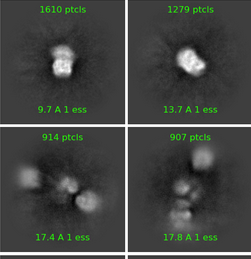I’m new to cryoEM data analysis, and I don’t think I understand how masking works for 2d classification. I though a mask would apply a circle of the specified diameter to make the 2d classes, but I don’t understand how the mask could have both a “circular mask diameter (A)” and a “circular mask diameter outer (A)” parameter.
Can someone please explain how the circular mask requires two diameters? (and does the size in A automatically take into account binning of the particles if they were downsampled?)
Thank you!
1 Like
The reason is that the mask has a soft edge. The inner and outer diameters specify the softness of the edge.
1 Like
Thanks! That makes sense. Some of the particles that I imaged were complexes that consist of three particles arranged in a line. In a lot of the 2D classes, the outer two particles are really blurred. Could this be due to the outer particles being in the soft part of the mask? Or do these just look more like “junk” particles? Here is a picture of 4 of my classes (the top two are un-complexed single particles, and I think that the bottom two are the complexes). Thank you for your help!

the blurring of the outer particles certainly seem to be because they overlap with the mask edge. To verify this, you can try running a 2D job with masking and real space windowing turned off, or just extract in a larger box.
As to whether these are junk or real, that is hard to say - it certainly seems like the connectivity between the sub-particles is pretty tenuous/flexible, is this what you expect?
Cheers
Oli
1 Like
Hi Oli,
I’m not sure how flexible the particle interface is. I re-ran that 2d classification job with masking and real space windowing off as you suggested, and the classes don’t look much better. I’m going to pick the particles again, but this time with a larger separation- maybe I am just picking up particles that are too near to each other.
Thank you,
Hannah
